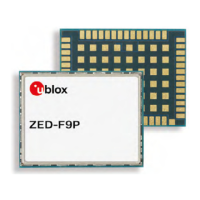ZED-F9P-Integration Manual
UBX-18010802 - R01
4 Electromagnetic
interference on I/O lines
Page 36 of 64
Objective Specification - Confidential
4 Electromagnetic interference on I/O lines
Any I/O signal line with a length greater than approximately 3 mm can act as an antenna and may
pick up arbitrary RF signals transferring them as noise into the GNSS receiver. This specifically
applies to unshielded lines, in which the corresponding GND layer is remote or missing entirely,
and lines close to the edges of the printed circuit board. If, for example, a cellular signal radiates
into an unshielded high-impedance line, it is possible to generate noise in the order of volts and
not only distort receiver operation but also damage it permanently. Another type of interference
can be caused by noise generated at the PIO pins that emits from unshielded I/O lines. Receiver
performance may be degraded when this noise is coupled into the GNSS antenna. To avoid
interference by improperly shielded lines, it is recommended to use resistors or ferrite beads on
the I/O lines in series. These components should be chosen with care because they will affect also
the signal rise times. Alternatively, feed-thru capacitors with good GND connection close to the
GNSS receiver can be used. EMI protection measures are particularly useful when RF emitting
devices are placed next to the GNSS receiver and/or to minimize the risk of EMI degradation due to
self-jamming. An adequate layout with a robust grounding concept is essential in order to protect
against EMI.
It is recommended that EMI filters or resistors are placed on the I/O lines as shown below:
Figure 36: ZED-F9P EMI protection
Intended Use: In order to mitigate any performance degradation of a radio equipment under
EMC disturbance, system integration shall adopt appropriate EMC design practice and not
contain cables over three meters on signal and supply ports.
4.1 General notes on interference issues
Received GNSS signal power at the antenna are very low. At the nominal received signal strength
(-128 dBm) it is below the thermal noise floor of -111 dBm . Due to this fact, a GNSS receiver is
susceptible to interference from nearby RF sources of any kind. Two cases can be distinguished:

